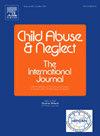Trends in substance use among child welfare-involved parents during the COVID-19 pandemic
IF 3.4
2区 心理学
Q1 FAMILY STUDIES
引用次数: 0
Abstract
Background and objective
Parental substance use is a major risk factor for child maltreatment, but the impact of the COVID-19 pandemic on substance use among parents involved in child welfare is not well understood. This study aimed to examine substance use patterns in child welfare cases from 2019 to 2022.
Participants and setting
Female parents assessed for child abuse or neglect using administrative data from the Ohio Statewide Automated Child Welfare Information System (Ohio SACWIS). Substance types were recorded during the family assessment at case entry.
Methods
A retrospective observational study was conducted to compare substance involvement before, during, and after the onset of the pandemic. Single changepoint analyses identified significant shifts in the mean percentage of cases involving substance use overall and for specific substances during selected weeks of each year.
Results
Among 264,380 women investigated, 65,796 (24.9 %) were involved with substance use. In 2020, the percentage of cases involving substance use peaked in the second quarter, driven by polysubstance and cannabis use. Changepoint analyses confirmed these changes. Only in 2020 did substance use cases significantly increase (32.4 % to 41.8 %) in week 10, coinciding with the national emergency declaration. Similar increases were observed for polysubstance and cannabis use.
Conclusions
The rise in substance-involved cases early in the pandemic corroborates national trends, with cannabis use notably driving this change, suggesting that parents may have used substances to cope. The high prevalence of polysubstance use highlights the need for targeted treatment programs and policy interventions for parental substance use.
COVID-19大流行期间参与儿童福利的父母的药物使用趋势
背景与客观父母药物使用是儿童虐待的主要危险因素,但COVID-19大流行对参与儿童福利的父母药物使用的影响尚不清楚。本研究旨在研究2019年至2022年儿童福利案件中的物质使用模式。参与者和设置的女性父母使用来自俄亥俄州全州自动儿童福利信息系统(俄亥俄州SACWIS)的行政数据评估儿童虐待或忽视。在病例进入时进行家庭评估时记录物质类型。方法采用回顾性观察性研究,比较大流行发生之前、期间和之后的物质介入情况。单变化点分析发现,在每年选定的几周内,涉及物质使用的总体和特定物质的平均百分比发生了重大变化。结果在调查的264380名妇女中,65796名(24.9%)涉及药物使用。2020年,在多种物质和大麻使用的推动下,涉及物质使用的案件百分比在第二季度达到峰值。变更点分析确认了这些变更。只有在2020年,药物使用案例在第10周显著增加(32.4%至41.8%),与国家紧急声明相吻合。多物质和大麻的使用也有类似的增加。在大流行早期,涉及药物的案件有所增加,这与国家趋势相吻合,大麻的使用明显推动了这一变化,这表明父母可能使用药物来应对。多种物质使用的高流行率突出表明需要针对父母物质使用制定有针对性的治疗方案和政策干预措施。
本文章由计算机程序翻译,如有差异,请以英文原文为准。
求助全文
约1分钟内获得全文
求助全文
来源期刊

Child Abuse & Neglect
Multiple-
CiteScore
7.40
自引率
10.40%
发文量
397
期刊介绍:
Official Publication of the International Society for Prevention of Child Abuse and Neglect. Child Abuse & Neglect The International Journal, provides an international, multidisciplinary forum on all aspects of child abuse and neglect, with special emphasis on prevention and treatment; the scope extends further to all those aspects of life which either favor or hinder child development. While contributions will primarily be from the fields of psychology, psychiatry, social work, medicine, nursing, law enforcement, legislature, education, and anthropology, the Journal encourages the concerned lay individual and child-oriented advocate organizations to contribute.
 求助内容:
求助内容: 应助结果提醒方式:
应助结果提醒方式:


